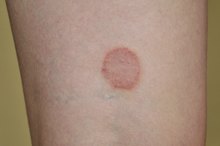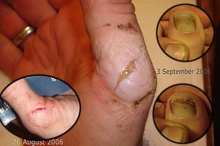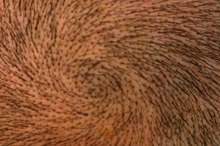Skin Problems That Cause Eyebrow Loss
Not having enough eyebrow hair can detract from a person’s appearance. Over-plucking is a common cause of depleted eyebrow hair growth, but numerous skin conditions also can cause eyebrow hair loss 2. Chronic skin disorders or infections may be to blame, and more rarely, serious illness may be involved.
Skin Disorders
Common chronic skin disorders can cause eyebrow hair loss 2. These skin conditions cause inflammation and irritation that can lead to hair falling out, or the hair can fall out due to itching, according to DermaDoctor. Eczema (atopic dermatitis) is characterized by extremely dry skin with itchy red patches and scaling. Psoriasis involves an abnormally rapid life cycle of skin cells leading to accumulation of dead cells, redness, thick scales and irritation. Contact dermatitis is an allergic skin reaction to substances, while seborrheic dermatitis, also known as seborrhea or dandruff, can affect facial hair as well as scalp hair.
Alopecia Areata
Scalp Conditions That Cause Hair Loss
Learn More
Alopecia areata is a common reason for hair loss, affecting about 2 percent of Americans, according to the National Institute of Arthritis and Musculoskeletal and Skin Diseases (NIAMS) 12. Alopecia areata is an autoimmune disorder in which the body's immune system attacks hair follicles 1. This typically leads to patchy hair loss on the scalp, but it can occur anywhere on the body, including the eyebrows and other facial hair 2. Alopecia areata is often a temporary condition 1.
Fungal Infection
The fungal infection Tinea capitis (ringworm) can occur not only on the scalp but on eyebrows and other facial hair, according to the U.S. National Institutes of Health (NIH) 23. This can cause temporary hair loss until treatment eliminates the fungus 2. People can contract ringworm through contact with infected individuals, or from surfaces such as furniture or bedding.
Lice
How to Treat Ringworm That Won't Go Away
Learn More
Lice, particularly pubic (crab) lice, which are attracted to short hair, can infiltrate eyebrows and eyelashes as well as other facial hair, according to the University of Pittsburgh Medical Center (UPMC) 34. Scratching these itchy areas can then lead to hair loss 2. Pubic lice are tiny and barely visible, and people typically become infected through sexual contact with infected individuals. They also can contract lice from contaminated surfaces such as toilet fixtures, furniture, clothing and linens.
Other Autoimmune Disorders
Vitiligo, a chronic autoimmune skin disorder that results in patchy areas of de-pigmentation, can cause eyebrow hair to lose pigment as well and turn gray. Vitiligo also can cause inflammation that leads to eyebrow hair loss, according to DermaDoctor 2. Another autoimmune disease, Lupus erythematosus, is sometimes associated with thinning hair and patchy hair loss, including eyebrow hair loss, due to skin inflammation and lesions 2.
Related Articles
References
- NIAMS: Alopecia Areata
- NIH: Hair Loss
- Oftalmologia: Tinea of the Eyebrows
- UPMC: Crab Lice
- Phillips TG, Slomiany WP, Allison R. Hair Loss: Common Causes and Treatment. Am Fam Physician. 2017;96(6):371-378.
- Watras MM, Patel JP, Arya R. Traditional anticoagulants and hair loss: a role for direct oral anticoagulants? A review of the literature. Drugs Real World Outcomes. 2016;3(1):1-6. doi:10.1007/s40801-015-0056-z
- Urysiak-czubatka I, Kmieć ML, Broniarczyk-dyła G. Assessment of the usefulness of dihydrotestosterone in the diagnostics of patients with androgenetic alopecia. Postepy Dermatol Alergol. 2014;31(4):207-15. doi:10.5114/pdia.2014.40925
- Vincent M, Yogiraj K. A descriptive study of alopecia patterns and their relation to thyroid dysfunction. Int J Trichology. 2013;5(1):57-60. doi:10.4103/0974-7753.114701
- Peters EMJ, Müller Y, Snaga W, et al. Hair and stress: A pilot study of hair and cytokine balance alteration in healthy young women under major exam stress. PLoS ONE. 2017;12(4):e0175904. doi:10.1371/journal.pone.0175904
- Pratt CH, King LE, Messenger AG, Christiano AM, Sundberg JP. Alopecia areata. Nat Rev Dis Primers. 2017;3:17011. doi:10.1038/nrdp.2017.11
- American Academy of Dermatology. Alopecia Areata: Overview.
Writer Bio
Shelley Moore is a journalist and award-winning short-story writer. She specializes in writing about personal development, health, careers and personal finance. Moore has been published in "Family Circle" magazine and the "Milwaukee Sentinel" newspaper, along with numerous other national and regional magazines, daily and weekly newspapers and corporate publications. She has a Bachelor of Science in psychology.









